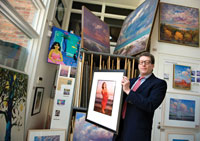From an actor to a dancer to an art museum director, 13 Baltimoreans share what they've learned from their long careers in the arts.
 The Gallery Owner
The Gallery Owner
In 1988, Steven Scott took a chance and opened his own art gallery on Charles Street to showcase established American artists. Twenty-three years and two moves later, more than half of the gallery's 20 represented artists remain from that core group. At his newest location in Fells Point, he'll be highlighting the oils and monotypes of seven of his artists in this fall's show, "Painterly Brushwork," Oct. 4 through Dec. 31.
I first fell in love with art in the first grade on a field trip to the National Gallery. I saw the Renoir painting 'A Girl with a Watering Can.' I was drawn to the dazzling light, the inspired composition, the extraordinarily rich color and the intermittent flecks of sunlight infusing the surface of the canvas. The painting truly glowed.
I didn't always know that I wanted my own gallery. I originally thought I would be a museum curator. When I worked in the museums, I found local and regional artists that had great talent but no representation in Baltimore or D.C. After following their work for a few years, I found that I had a high-quality group of artists that were saleable and important. So I took a leap.
It's feast or famine. The winters are slow and the summers are busy. I can tell how well the gallery is doing by looking at the stack of art magazines on my desk. If there's a large stack and lots of e-mails, then I'm behind. If I'm caught up, we're having a slow period. It's always a roller coaster ride, but it all evens out in the end.
If you have a dedicated collector base and a quality group of artists you stick with, even new galleries can make it in Baltimore.
Many people are scared because conceptual art makes them feel stupid. You should always look, read and explore. Even with a graduate degree, I still don't understand Jackson Pollock. Or his allure, for that matter.
In '89, a collector walked into the Charles Street gallery with a big green trash bag over her shoulder. She threw it down in the middle of the floor and out came huge ornate, purple drapes. She needed a large purple painting to match the purple drapes! I tried to discourage her from buying to match— art should blend, but you should buy it because you love it.
The most important thing an artist can do is come up with a signature style—the kind where even if there is no sign, you can look at it and know who created it.
Many of my artists are set in their ways. I have to treat some with kid gloves. But the majority have been an absolute pleasure to work with. I support them and they support me. I know their quirks after 23 years. My artists stay true and paint for themselves, not the marketplace.
Some people just buy a piece to match their sofa or walls. Homes are not museums; there are restrictions with what you can display. Art needs to blend and enhance.
A large percentage of people that come to galleries don't know the difference between lithographs and screen prints. It's part of my job to educate— not everyone is an aficionado. When collectors understand the technique, they appreciate the pieces so much more.
If you really look at the works, it should take 10 visits to see the National Gallery. —As told to Laura Lefavor
Link to the Original Article.
Courtesy Baltimore Style Magazine, Sept/Oct 2011, p. 135



